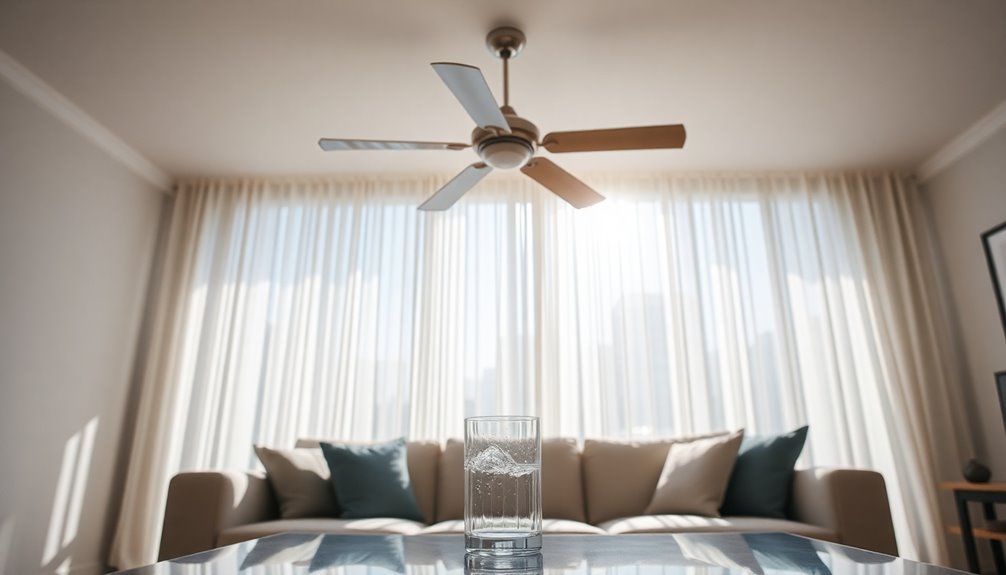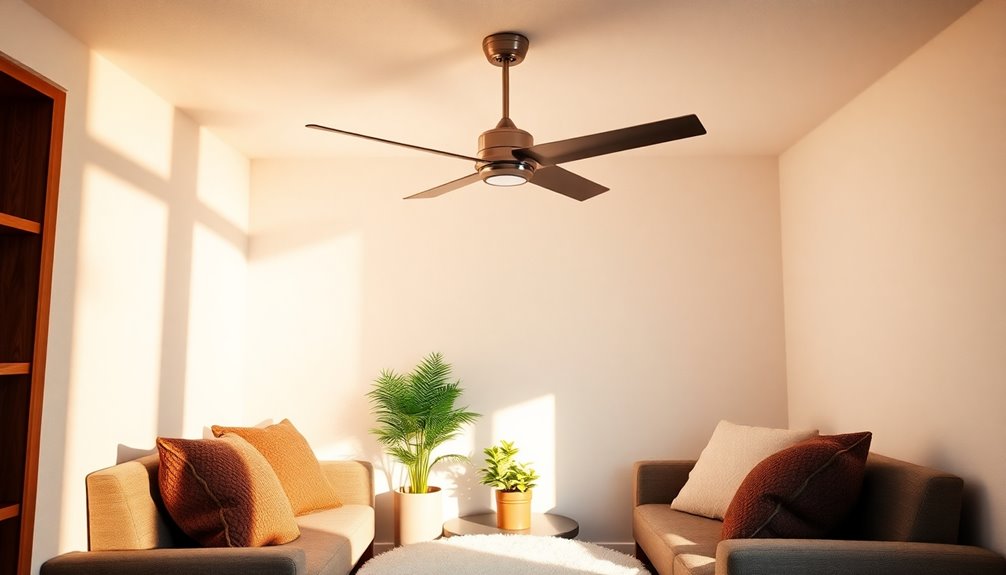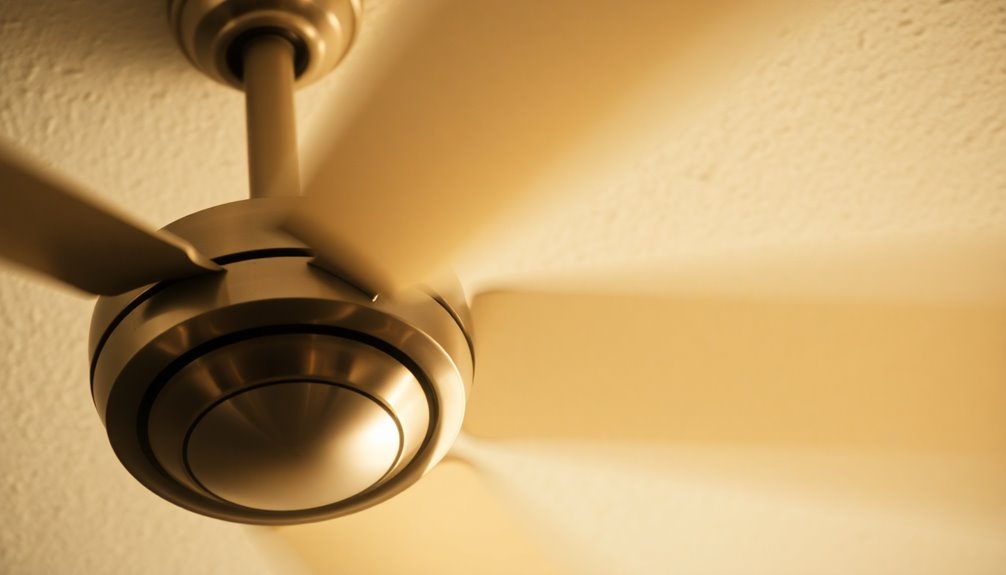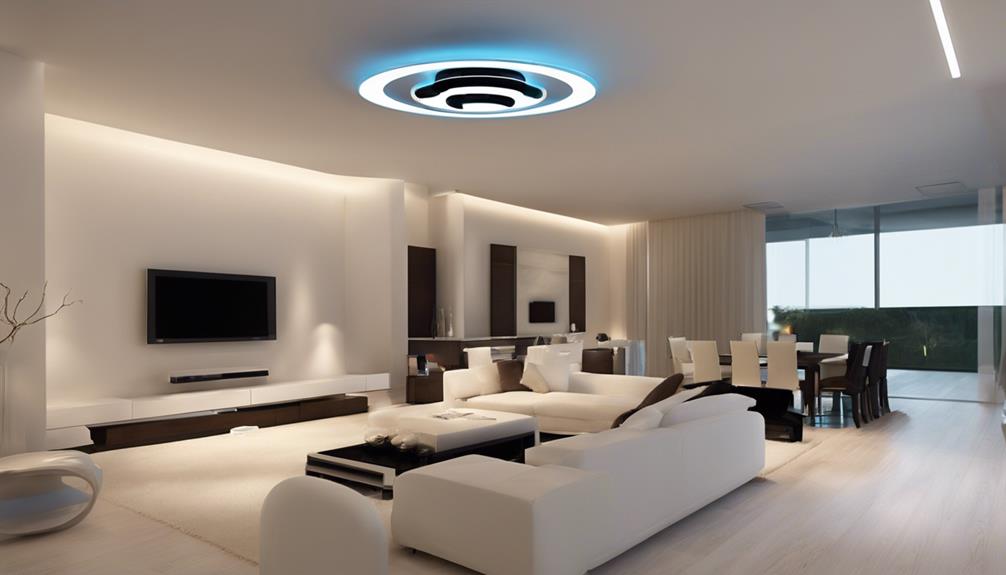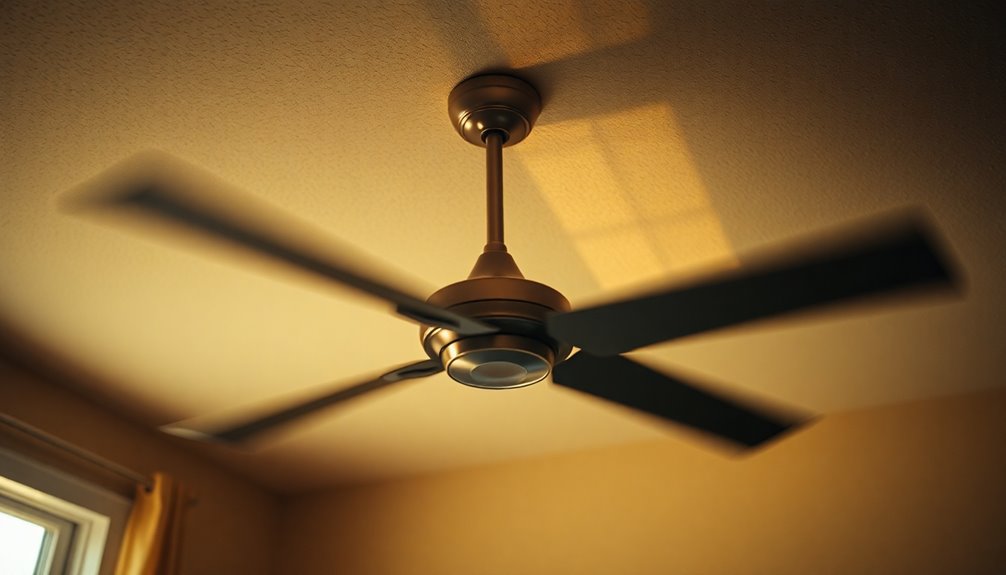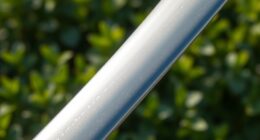Ceiling fans don't actually cool a room like an air conditioner does. Instead, they create airflow that enhances your comfort by producing a wind chill effect. This effect helps evaporate sweat from your skin, making you feel cooler even though the room temperature stays the same. To get the best cooling sensation, make sure the fan runs counterclockwise in summer and only operates in occupied spaces. By using fans wisely, you can also lower your cooling costs. If you're curious about maximizing the benefits of ceiling fans, there are more tips and tricks to explore.
Key Takeaways
- Ceiling fans do not lower room temperature; they enhance comfort through the wind chill effect on the skin.
- Fans improve perceived cooling by promoting evaporation of sweat, but they do not cool unoccupied spaces.
- Running a ceiling fan consumes significantly less energy than air conditioning, making it a cost-effective cooling option.
- To maximize efficiency, use fans only in occupied rooms and turn them off when not in use.
- For optimal airflow in summer, set ceiling fans to rotate counterclockwise.
Understanding Ceiling Fan Functionality

When you think about ceiling fans, it's important to understand how they actually work. Ceiling fans don't lower the room temperature; they create airflow that enhances your comfort level, thanks to the wind chill effect. As the fan blades rotate, they move air throughout the space, allowing for more effective cooling. This increased airflow helps evaporate sweat from your skin, which is your body's natural cooling process.
For a ceiling fan to be effective, the airflow needs to directly contact your skin. Stagnant air can actually lead to a rise in room temperature, making it feel uncomfortable. By circulating air, ceiling fans prevent heat from accumulating, creating a more comfortable environment. Additionally, using a ceiling fan can help you feel warmer when paired with electric heated mattress pads, which provide cozy warmth during colder nights. Furthermore, energy-efficient heat pumps can work in conjunction with ceiling fans to optimize indoor climate control. Air purifiers can also enhance your indoor air quality, making your environment more comfortable. In fact, using a ceiling fan alongside a heat pump can significantly improve energy efficiency, reducing overall energy consumption. The combination of these systems can lead to improved cost savings on your utility bills.
They work best when used alongside your air conditioning system, helping to improve energy efficiency by allowing you to set your thermostat a bit higher while still feeling cool.
Using a ceiling fan can make a significant difference in how you experience your space. So next time you adjust your thermostat setting, remember that a ceiling fan can enhance your comfort without the need for excessive cooling.
The Wind Chill Effect

When you turn on a ceiling fan, it doesn't actually lower the room's temperature, but it creates a wind chill effect that makes you feel cooler.
This happens because the moving air boosts evaporation from your skin, enhancing your comfort.
Airflow vs. Temperature
Though ceiling fans don't actually lower the room temperature, they create a wind chill effect that greatly enhances your comfort level. This effect happens when airflow carries heat away from your body, making you feel cooler, even if the actual temperature remains the same. For ideal perceived comfort, it's essential that the air movement from the ceiling fan directly contacts your skin. Otherwise, the fan may redistribute warmer air, which can lead to discomfort.
Using ceiling fans allows you to increase your thermostat settings, as the cooling effect from the airflow makes warmer temperatures feel more tolerable. This not only enhances your comfort but also leads to potential energy savings during hot months. Here's a quick overview of the wind chill effect vs. temperature:
| Aspect | Description |
|---|---|
| Airflow | Moving air that enhances comfort |
| Temperature | Remains unchanged despite fan use |
| Wind Chill | Feeling cooler due to air movement |
| Cooling Effect | Achieved through evaporation on the skin |
| Energy Savings | Higher thermostat settings with fan usage |
Evaporative Cooling Mechanism
The evaporative cooling mechanism, often referred to as the wind chill effect, plays an essential role in how ceiling fans enhance comfort in warm environments. When you're using ceiling fans, they don't actually lower the room temperature, but they create a breeze that helps you feel cooler. This occurs through evaporative cooling, where moisture evaporates from your skin, making you more comfortable.
By increasing air circulation, ceiling fans can make a room feel up to 10°F cooler. This means you can set your thermostat higher while still enjoying a pleasant atmosphere. To maximize this effect, make sure your ceiling fan is rotating counterclockwise during warm months. This rotation creates a downward draft, enhancing the cooling sensation for everyone in the space.
However, keep in mind that the wind chill effect relies on direct airflow over your skin. If no one is present to benefit from the airflow, a ceiling fan won't cool the room.
Consequently, strategically using your ceiling fan not only enhances your comfort but also allows for higher thermostat settings, making it an efficient choice during warmer days.
Energy Efficiency Benefits

When it comes to energy efficiency, ceiling fans really shine compared to air conditioners.
You can save considerably on your cooling costs by adjusting your thermostat and strategically using fans.
Plus, modern fans use far less energy, making them a smart choice for your home.
Energy Consumption Comparison
Ceiling fans are a smart choice for anyone looking to cut down on energy costs while staying cool. When you compare their energy consumption to air conditioning, the difference is staggering.
Ceiling fans typically use about 60 watts, while central air conditioners can consume between 3000-3500 watts per hour. This means that running a ceiling fan for a whole day can use less energy than just 15 minutes of air conditioning!
Here are some key points about the energy efficiency of ceiling fans:
- Reduce cooling costs: Using a ceiling fan alongside air conditioning can lower your cooling costs by about 12%.
- Energy Star-rated options: These fans offer even better energy efficiency, consuming less power while delivering effective airflow.
- Adjust thermostat settings: You can raise your thermostat settings by 4°F to 7°F without sacrificing comfort when using a ceiling fan.
- Reduce reliance on air conditioning: Fans allow you to enjoy a cool environment while minimizing your dependence on energy-hungry air conditioners.
- Complementary airflow systems: Ceiling fans work effectively with heat pump technology, enhancing the overall efficiency of your cooling system.
Thermostat Adjustment Benefits
Adjusting your thermostat in conjunction with ceiling fan use can lead to considerable energy savings and increased comfort. By raising your thermostat settings by about 4°F while running ceiling fans, you can stay comfortable without cranking up your air conditioning. This simple thermostat adjustment not only enhances your comfort but also reduces cooling costs by up to 30-40%. Additionally, understanding the impact of heat pump efficiency can help further optimize your home's cooling strategy.
Using ceiling fans is a cost-effective cooling strategy; they consume only about 1% of the energy used by air conditioners. By combining ceiling fans with air conditioning, you can lower your utility bills and reduce overall energy consumption. Incorporating smart bathroom technologies can also play a role in enhancing energy efficiency throughout your home.
This approach allows you to maintain a comfortable environment while considerably cutting down on energy costs. Moreover, effective use of ceiling fans can lead to potential savings of around 12% on cooling costs. By reducing your reliance on air conditioning, you'll notice the difference in your utility bills.
Ultimately, the synergy between ceiling fans and thermostat adjustments can create a balanced, energy-efficient cooling solution that benefits both your wallet and the environment. Additionally, understanding the principles of heat pump mechanics can further enhance your home's overall energy efficiency.
Strategic Fan Usage
Maximizing your ceiling fan's efficiency can greatly enhance your cooling strategy during warmer months. While ceiling fans don't actually cool the room, they create a wind chill effect that can make you feel cooler. This allows you to raise your thermostat settings by about 4°F without sacrificing comfort, helping you save energy and reduce reliance on air conditioning. Additionally, using a ceiling fan in conjunction with a modern heat pump system can optimize comfort and energy efficiency. High-end ceiling fans often feature energy-efficient motors, which further enhance their performance and sustainability.
Here are some tips for strategic fan usage:
- Use fans in occupied rooms: They enhance air circulation, boosting air conditioning efficiency and potentially cutting cooling costs by up to 40%. Additionally, integrating energy-efficient systems can further amplify these savings.
- Turn off fans in unoccupied spaces: Since fans only cool people, not rooms, this prevents unnecessary energy expenditure.
- Run fans continuously: They consume only about 1% of what air conditioners use, so running a fan for 24 hours uses less energy than just 15 minutes of AC.
- Combine with higher thermostat settings: This can lead to energy savings of around 12% on overall cooling costs.
Additionally, modern Energy Star certified fans can significantly contribute to energy savings while maintaining comfort levels in your home.
Cost Savings With Ceiling Fans

Using a ceiling fan can lead to significant cost savings on your cooling bills. By effectively using ceiling fans alongside your air conditioning, you can reduce cooling costs by about 12%. This allows you to raise your thermostat settings by about 4°F, helping you save on energy without sacrificing comfort.
Consider this: running a ceiling fan for 24 hours consumes less energy than just 15 minutes of air conditioning. This makes ceiling fans a smart and cost-effective choice for cooling your home.
They primarily cool people rather than rooms, which means you're minimizing energy usage in unoccupied spaces.
Proper Usage Techniques

To make the most of your ceiling fan, it's important to understand how to use it effectively. Ceiling fans don't lower the room temperature; they create airflow that enhances the wind chill effect, making you feel more comfortable.
Here are some proper usage techniques to maximize efficiency:
- Set the ceiling fan to rotate counterclockwise during summer to push cool air downwards.
- Use the fan in occupied rooms only, allowing you to raise your thermostat settings by up to 4°F without sacrificing comfort.
- Turn off the fan in unoccupied spaces to avoid wasting energy costs; remember, fans cool people, not rooms.
- Verify proper placement by installing the fan with blades 7-9 feet above the floor and 10-12 inches below the ceiling for peak airflow.
Common Myths Debunked

Many people fall for common myths about ceiling fans that can lead to inefficient use and higher energy costs. One prevalent myth is that ceiling fans lower the temperature in a room. In reality, they create a wind chill effect that enhances your comfort without actually changing the air temperature. This means running a ceiling fan in an empty room is wasteful since it only cools people, not spaces.
Another misconception is that leaving ceiling fans on will cool a room. To save on energy costs, you should turn off the fan when no one is present.
It's also important to know that not all fans are the same. For peak cooling capacity, set your ceiling fan to rotate counterclockwise in the summer and clockwise in the winter for better air circulation.
Finally, some believe ceiling fans can replace air conditioning. While they can enhance comfort, they work best when used alongside your AC system to reduce your cooling bill and energy costs.
Selecting the Right Ceiling Fan

When it comes to selecting the right ceiling fan, size and efficiency are key factors. You'll want to choose a fan that fits your room's dimensions and helps keep energy costs low. Additionally, selecting the right fan type can impact overall pricing and functionality.
Pay attention to the blade span—fans with a diameter of 36-44 inches work well for rooms up to 225 square feet, while 52-inch or larger fans are ideal for bigger spaces. Best Air Flow Ceiling Fans are specifically designed to enhance comfort in larger areas. Regular maintenance of the fan, such as cleaning filters, can help ensure it operates efficiently over time. Many ceiling fans also come with smart home device integration features, allowing you to control them remotely for added convenience.
Here are some tips to guide your selection:
- Choose Energy Star-rated ceiling fans for better airflow efficiency and reduced energy costs.
- Install fan blades at 7-9 feet above the floor and 10-12 inches below the ceiling for peak performance.
- Opt for fans with larger blades, as they're generally more effective at moving air.
- Consider noise levels; high-quality motors guarantee quieter operation, enhancing your comfort. Additionally, HEPA filters can significantly improve indoor air quality while using ceiling fans to circulate air.
Frequently Asked Questions
Does a Ceiling Fan Actually Cool the Room?
When you ask if a ceiling fan cools a room, it's important to know that it doesn't actually lower the temperature.
Instead, it creates airflow that makes you feel cooler by enhancing the wind chill effect. The fan helps evaporate moisture from your skin, which is why you feel relief on hot days.
Just remember, it's effective only when you're in the room, so don't leave it running in empty spaces.
How Much Colder Does a Ceiling Fan Make a Room?
A ceiling fan doesn't actually make a room colder. Instead, it creates a wind chill effect, making you feel about 4°F to 7°F cooler than the air temperature.
This happens because the fan circulates air, enhancing sweat evaporation from your skin. While it improves your comfort, it doesn't lower the room's temperature.
How Effective Are Ceiling Fans for Cooling?
You might think that ceiling fans are like magical devices that drop temperatures, but they don't actually cool air. Instead, they give you that invigorating breeze you crave by moving air around, enhancing your comfort.
If you position them right and run them counterclockwise in summer, you'll feel the difference. Plus, they use way less energy than AC units, making them a smart choice for keeping cool while saving on bills.
Do Ceiling Fans Push Hot Air Down?
Yes, ceiling fans can push hot air down.
When you set your fan to rotate clockwise, it creates a downdraft that circulates warm air from the ceiling back into the room. This airflow helps redistribute heat, preventing it from stagnating near the ceiling.
By enhancing air circulation, you can feel more comfortable, especially when you combine the fan with other cooling methods.
Conclusion
In short, while ceiling fans don't actually lower the room's temperature, they create a revitalizing breeze that makes you feel cooler. By understanding their functionality and using them effectively, you can enjoy both comfort and energy savings. So, when it comes to beating the heat, you can't go wrong with a ceiling fan—it's a win-win! Just remember, you've got to keep it spinning to feel the benefits. Stay cool and make the most of your space!
